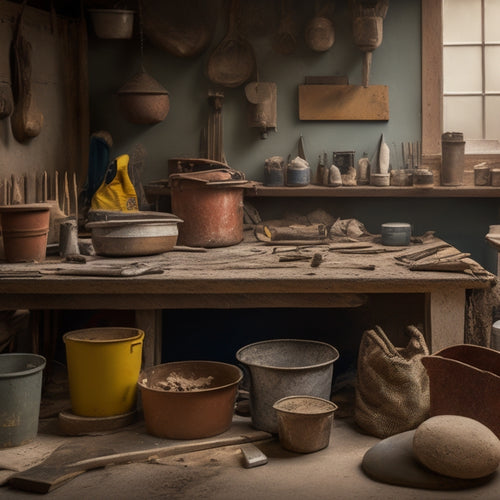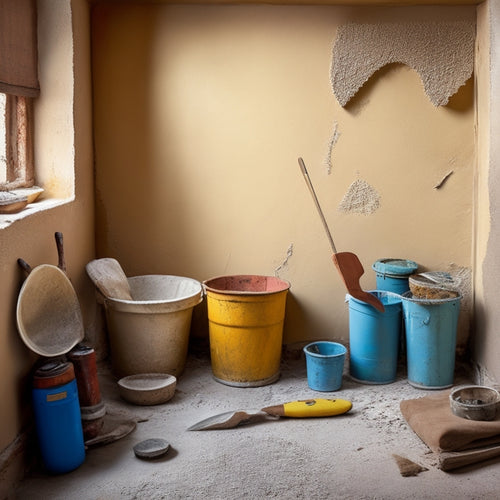
Tools Needed for Home Renovation Patching Fixes
Share
When tackling home renovation patching fixes, you'll need a variety of tools to get the job done right. Start with essential tools like hammers, trowels, and putty knives for surface preparation and application. Don't forget cleaning tools like wire brushes and safety gear like masks and gloves to protect yourself from dust and debris. You'll also need mixing and measuring tools, like buckets and measuring cups, to guarantee accurate mixing ratios. Additionally, specialized tools like edging and finishing tools, dustless sanding systems, and corner bead tools will help you achieve a smooth, professional-looking finish. As you gather your tools, you'll be well on your way to achieving a successful renovation.
Key Takeaways
• Essential tools for concrete patching include hammers, trowels, putty knives, wire brushes, and safety gear like masks and gloves.
• Mixing and measuring tools, such as clean buckets and measuring cups, ensure accurate mixing ratios for strong adhesion.
• Application and smoothing tools, like putty knives and sanding blocks, help achieve a uniform surface and prevent uneven patterns.
• Edging and finishing tools, including utility knives and drywall edge scrapers, aid in creating clean edges and precise corners.
• Safety equipment, such as dust masks, protective eyewear, and sturdy gloves, protect against airborne debris, cuts, and abrasions during renovation.
Essential Concrete Patching Tools
You'll need a few specialized tools to successfully patch concrete, including a hammer, trowel, and putty knife. These tools will help you prepare the surface, apply the patching compound, and smooth out the area.
A wire brush is also vital for cleaning the area and removing any debris or loose concrete.
When it comes to concrete patching techniques, it's important to get it right to avoid common patching mistakes. For instance, failing to clean the area properly can lead to a weak bond between the old and new concrete.
Using the right tools will also help you avoid mistakes such as applying too much pressure, which can cause the patch to sink or bulge. A level and a straightedge can guarantee the patch is even and smooth.
Additionally, a safety mask and gloves will protect you from inhaling dust and debris or getting injured by sharp edges.
Mixing and Measuring Tools
When tackling a home renovation project, having the right mixing and measuring tools on hand is vital for achieving accurate ratios and consistent results. You'll need a clean, dry bucket or mixing container, a mixing stick or trowel, and a measuring cup or scale to guarantee you're following the manufacturer's instructions.
Don't skip on quality - a sturdy mixing stick can withstand thick mixes, while a digital scale provides precise measurements.
When it comes to measuring techniques, it's important to follow the correct mixing ratios. Take the time to read the instructions carefully, and double-check your measurements before adding water or mix.
A common mistake is adding too much water, which can lead to a weak bond or crumbling patch. To avoid this, start with the recommended ratio and adjust as needed. Remember, it's always better to err on the side of caution and add water gradually.
Surface Preparation Tools Needed
When you're about to start a renovation project, you'll need to prepare the surface area to guarantee a smooth and successful outcome.
You'll need to clean the surface area to remove dirt, grime, or old finishes, which can affect the adhesion of new materials.
Next, you'll have to remove old adhesive or residue and sand rough edges to create a uniform surface.
Clean the Surface Area
Before applying any new finishes or materials, sweep, vacuum, or blow away debris from the surface area to guarantee a clean slate for your renovation project. This vital step guarantees a strong bond between old and new surfaces, preventing future cracks and weaknesses.
For effective surface cleaning techniques, start by removing loose particles with a broom, dustpan, or a leaf blower. Next, use a vacuum cleaner with a gentle suction setting to pick up finer dust and dirt.
For tougher dirt and grime, apply effective cleaning agents like mild detergents or specialized cleaners specifically designed for your surface type (wood, concrete, etc.). Avoid using harsh chemicals or abrasive materials that can damage the surface.
Always follow the manufacturer's instructions and take necessary safety precautions, such as wearing gloves and protective eyewear. A clean surface is essential for a successful renovation project, so take your time to get it right.
Remove Old Adhesive
You'll likely need to remove old adhesive residue, a stubborn obstacle that can hinder the success of your renovation project, using a combination of specialized tools and techniques.
When it comes to adhesive removal, it's vital to identify the type of adhesive you're dealing with, as different types require unique approaches. For example, solvent-based adhesives, like epoxy or acrylic, typically respond well to chemical-based adhesive removal techniques, such as using solvents like acetone or mineral spirits.
On the other hand, water-based adhesives, like those used in construction or flooring, may require mechanical removal methods, such as scraping or grinding.
Comparing adhesive types is important in selecting the most effective removal method.
Be sure to wear protective gear, including gloves and safety glasses, when working with chemicals or mechanical tools to avoid injury. Additionally, make certain the area is well-ventilated and follow the manufacturer's instructions for any chemicals or tools used.
Sand Rough Edges
With the old adhesive residue removed, turn your attention to sanding rough edges to confirm a smooth surface for your new materials.
Sanding is a significant step in surface preparation, and it's vital to get it right to guarantee a professional finish. Start by using a coarse-grit sandpaper (about 80-100) to remove any remaining imperfections or debris. As you sand, use gentle, circular motions to avoid scratching the surface.
Here are some important tools and sanding techniques to keep in mind:
-
Sandpaper: Start with coarse-grit (80-100) and progress to finer grits (120-150) for a smoother finish.
-
Sanding blocks: Use these to keep your sandpaper flat and prevent uneven sanding.
-
Edge sanders: Ideal for smoothing out curved or irregular edges.
-
Dust mask: Always wear one to protect yourself from inhaling dust and debris.
-
Safety goggles: Protect your eyes from flying particles.
Applying and Smoothing Tools
Tackling various applications and smoothing out surfaces requires a range of specialized tools that help you achieve professional-looking results.
When it comes to applying materials like joint compound, spackling, or drywall tape, you'll need tools that guarantee a smooth, even finish. Invest in a putty knife, specifically designed for scraping and spreading materials evenly. For larger areas, a taping knife or a joint knife will come in handy. These tools allow you to apply the right amount of pressure, guaranteeing a smooth finish.
For smoothing techniques, a sanding block is essential. It helps you achieve a uniform surface by preventing uneven sanding patterns. Additionally, a drywall sanding pad or a sanding sponge can be used for finer smoothing techniques. When working with drywall, a drywall rasp is perfect for smoothing out rough edges and bumps.
Edging and Finishing Tools
Three essential edging tools - a utility knife, a drywall edge scraper, and a corner bead tool - will help you achieve crisp, clean edges and precise corners in your renovation project. These tools will enable you to master various edging techniques, ensuring a professional finish.
To add those finishing touches, you'll also need:
A putty knife for applying and smoothing joint compound
A sanding block for feathering out edges and creating a seamless blend
A drywall tape applicator for reinforcing joints and corners
A miter saw or a miter box for making precise angled cuts
A dustless sanding system for minimizing mess and maximizing safety
With these tools in your arsenal, you'll be able to tackle even the most intricate edging tasks with confidence.
Remember to always follow safety guidelines and best practices when working with power tools and sharp objects.
Cleaning and Protective Gear
When you're in the midst of a home renovation, you'll be dealing with plenty of dust, debris, and hazardous materials.
To guarantee your safety, you'll need to prioritize cleaning and protective gear, starting with the essentials: a reliable dust mask and protective eye wear that can withstand the demands of your project.
Dust Mask Essentials
You'll need a reliable dust mask to shield yourself from airborne debris and contaminants, making it an essential addition to your cleaning and protective gear arsenal.
With so many dust mask types available, it's vital to choose one that suits your specific needs. Consider factors like filter quality, comfort, and adjustability when selecting a dust mask.
To guarantee your dust mask remains effective, regular maintenance is key. Here are some essential tips:
-
Inspect your dust mask before each use for signs of wear or damage.
-
Clean your dust mask regularly with mild soap and water.
-
Store your dust mask in a dry, clean environment to prevent moisture buildup.
-
Replace filters according to the manufacturer's instructions.
-
Consider having multiple dust masks on hand in case one becomes compromised.
Protective Eye Wear
Protective eye wear is a significant component of your cleaning and protective gear arsenal, shielding your eyes from debris, chemicals, and other hazards that can cause serious injury. When it comes to home renovation patching fixes, you'll be working with power tools, chemicals, and materials that can pose a substantial threat to your eye health. That's why it's essential to invest in high-quality protective eyewear.
| Type of Protective Eyewear | Description |
|---|---|
| Safety Glasses | Provide basic protection against flying debris and particles |
| Goggles | Offer additional protection against chemicals and liquids |
| Face Shields | Protect your entire face from splashes and sprays |
| Prescription Safety Glasses | Customized to fit your prescription needs |
| Welding Helmets | Specialized for welding and high-heat applications |
Specialized Concrete Repair Tools
For concrete repair projects that require more than just a cosmetic fix, specialized tools like mixing paddles and trowels help you achieve a strong, long-lasting bond between old and new concrete. These tools are vital for concrete repair techniques that involve applying the best patching compounds to damaged areas.
When working with concrete, it's important to have the right tools for the job to guarantee a successful repair.
Here are some specialized concrete repair tools you'll need:
-
Mixing paddles: for blending patching compounds to the right consistency
-
Trowels: for applying and smoothing out the compound
-
Chisels: for removing old, damaged concrete
-
Grout saws: for cleaning out joints and preparing them for new grout
-
Concrete edgers: for creating a clean, defined edge around the repair area
Safety Equipment for the Job
Wearing the right gear is essential when tackling a concrete repair project, as it can literally mean the difference between safety and serious injury. As you prepare for the job, make sure you have the necessary safety equipment to protect yourself from potential hazards.
Start with a pair of sturdy gloves to prevent cuts and abrasions from rough concrete surfaces. Safety glasses or goggles will shield your eyes from debris and dust. A dust mask or respirator will also help you breathe easily in dusty environments. Don't forget a hard hat to protect your head from falling objects or collapsing structures.
Developing safety protocols is vital to prevent accidents. Identify potential risks and create emergency procedures for each scenario. For instance, have a first aid kit on hand in case of minor injuries.
Know the location of the nearest hospital or medical facility in case of more serious incidents. By prioritizing safety, you'll be able to focus on the task at hand and complete your concrete repair project with confidence. Remember, safety isn't just a precaution – it's a necessity.
Frequently Asked Questions
Can I Use a Single Tool for Multiple Patching Tasks?
When tackling patching tasks, you might wonder if one tool can do it all. The good news is, yes, you can use multi-tasking tools for versatile patching!
For instance, a putty knife can scrape, spread, and smooth out surfaces. A utility knife can cut, scrape, and trim.
How Do I Store My Tools to Prevent Damage and Rust?
"When it rains, it pours" - and when it comes to tool storage, a little planning goes a long way.
You'll want to prioritize tool organization to prevent damage and rust. Start by designating a dry, well-ventilated area for storage. Use airtight containers or bags to keep moisture at bay.
Label each container so you can easily find what you need. Consider investing in a tool chest or pegboard to keep frequently used items within reach.
With a little effort, you'll be able to breathe easy knowing your tools are safe and ready for the next project.
Are There Any Eco-Friendly Alternatives to Traditional Patching Tools?
When looking for eco-friendly alternatives to traditional patching tools, you'll find sustainable materials and biodegradable options that are gentler on the environment.
Consider using bamboo or recycled metal tools, which reduce waste and minimize carbon footprint.
For patching compounds, opt for natural, plant-based products or those made from recycled materials.
These alternatives not only benefit the planet but also guarantee a safer, healthier workspace for you.
Can I Borrow Tools From Friends or Family for Small Projects?
When borrowing tools from friends or family, you'll want to exercise good tool sharing etiquette.
Before asking, consider whether the tool is suitable for your project and if you can return it promptly. Be respectful of the lender's property and time, and offer to compensate for any wear and tear.
Borrowing considerations also include ensuring you're familiar with the tool's operation and safety guidelines to avoid accidents.
Do I Need to Calibrate My Tools Before Starting a Project?
You're about to start a project with a million tiny details, but don't even think about lifting a finger until you've calibrated your tools!
Proper tool calibration is essential for accuracy, and accuracy is key to a safe and successful project.
If your tools are off, even by a hair, it can throw off your entire project.
Take the time to verify your tools are calibrated correctly, and you'll reap the benefits of precision and confidence.
Conclusion
You've got the know-how and the right tools to tackle that home renovation patching fix like a pro!
With your arsenal of concrete patching tools, you're ready to conquer even the most intimidating cracks and craters.
It's time to get down to business and transform your space into a masterpiece that'll make the pros green with envy - or at least make your neighbors wonder if you secretly hired a team of experts!
Related Posts
-

Streamlining Your Exterior Renovation Timeline
To streamline your exterior renovation timeline, start by identifying your project goals and objectives, and prioriti...
-

What Plastering Tools Do You Need for Renovation
You'll need a range of specialized tools to tackle a plastering renovation project efficiently and effectively. Essen...
-

Stucco Patching Material Checklist for Home Renovation
You'll need a range of essential tools, including a putty knife, wire brush, hawk or flat trowel, level, and straight...


